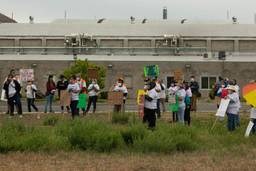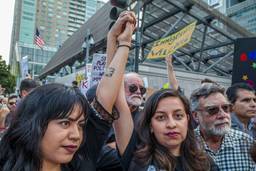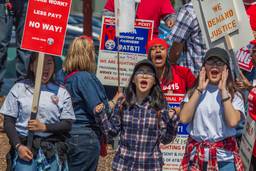
For anyone who loves the labor movement, it’s not unreasonable today to ask whether we’ve lost our way. California’s huge healthcare local is in trusteeship, its leading organizing drive in a shambles. SEIU’s international is at war with its own members, and now with UNITE HERE, whose merger of garment and hotel workers is unraveling.
In 1995, following the upsurge that elected John Sweeney president of the AFL-CIO, the service and hotel workers seemed two of the unions best able to organize new members. Their high-profile campaigns, like Justice for Janitors and Hotel Workers Rising, were held out as models. Today they’re in jeopardy.
This conflict has endangered our high hopes for labor law reform, and beyond that for an economic recovery with real jobs programs, fair trade instead of free trade, universal healthcare, and immigration reform that gives workers rights instead of raids. The ability of unions to grow in size and political power is on the line.
Today only 12 percent of workers belong to unions, and less in the private sector — the lowest level of organization since the years before the great longshore strike of 1934. And falling numbers aren’t the whole story.
Some labor leaders now say that only huge deals at the top, far from the control of rank-and-file workers, can bring in new members on the scale we need. To make those deals attractive to employers, they argue, unions have to be willing to make deep concessions in wages and rights, and in our political demands — on everything from single-payer healthcare to immigration reform.
We need some better ideas about how unions should organize — we need to rethink even what a union actually is.
Part of our difficulty is that our labor movement, and workers themselves, think about their interests in relatively narrow terms. By comparison with workers in South Africa, El Salvador, or even Mexico and Canada, we are very conservative and reluctant to see the root of our problems in the system itself, or to talk openly about the need to change it drastically. It is more important than ever that workers see their class interest. But what is that interest? And how should we defend it?
Our labor movement has resources and wealth that are enormous by comparison with most unions around the world. But what good is it if we don’t at least use it effectively to defend ourselves, or if it even becomes a brake on our willingness to take risks, like those French workers who lock their bosses in their offices, or Mexican workers, who facing the declaration of their strike in Cananea as illegal, have defied and fought it for the last two years?
Over the last four decades, corporations have built an international system of production and distribution that links together the workers of many countries, but in which workers have no control over the expropriation and distribution of the wealth they create. Further, this system has forced devastating and permanent unemployment on entire generations of U.S. workers, especially in African-American and Chicano neighborhoods.
Meanwhile, neo-liberal economic policies displace communities in developing countries, creating a reserve labor force of hundreds of millions, migrating both within and across borders, desperate for work.
Employers have always used the migration of people to this country as a labor supply system. Today that use is more overt than ever. NAFTA alone created such displacement in Mexico that over 6 million Mexican workers and farmers have come here looking for a way to guarantee their families’ survival. Our immigration policy is then used as the means to criminalize not just their labor (by making it a federal crime for a worker without papers to have a job) but the very status of millions of people, who, like everyone else, have no alternative but to work.
Large corporations, with allies in the administration, among lobbying groups in Washington, and even in our labor movement itself, are now proposing changes that would substitute contract labor programs for family reunification, force all workers to carry a national ID in order to work, and require the firing of millions of workers who can’t get the required “work authorization.”
Our labor movement was organized by immigrants and their children — by people who came from somewhere else. But our unions have been organized in a working class deeply divided by race and nationality. The key issue confronting our labor movement for the last 180 years is inclusion or exclusion.
Today, undocumented immigrants ask: Will the unions I paid my dues to defend me when the government tells my boss to fire me because I don’t have papers? It’s not an abstract question. Two-hundred and fifty-four workers at Overhill Farms, fired two months ago in Los Angeles, are asking that question to UFCW Local 770 today.
For unions and workers to survive in this environment, they must demand increasingly radical reforms. Accepting the limits of “what’s politically possible” as defined by Washington insiders, whether they seek to prevent discussion of single-payer or the repeal of employer sanctions, is a recipe for disaster. We cannot defend ourselves if our only goal is to “be at the table.”
Each month for almost a year, over half a million people have lost their jobs. Meanwhile, banks have been showered with hundreds of millions of dollars to keep them afloat, while working families can’t get their loans renegotiated so they can stay in their homes. Yet there has been no national demonstration called by either labor federation, demanding a direct federal jobs program or redirecting the bailout to workers instead of the wealthy.
[Editor’s note: Part 2 of “Can Labor Get Out of This Mess?” can be read here.)







